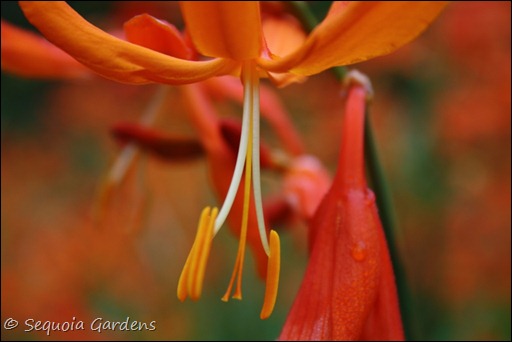
The most striking, the easiest – indeed, you might even say the weediest – of our wild flowers on Sequoia is Crocosmia aurea. It is orange. Amazingly, overwhelmingly orange, as only a plant that uncompromisingly exists in all its parts and stages in shades of one colour can be.

Flower spikes are carried high on wiry stems that zigzag appealingly from bud to bud. They are beautifully graphic in the bud stage, but somehow become muddled and unphotogenic once opened. I so wish I had taken the above picture a few days earlier to show you…

Even this photo seems to have angled itself in a way that barely shows the zigzag; but it looks good against masses of its own leaves as well as those of flag irises where it has sown itself with great enthusiasm in the bed opposite the garage, and strikingly visible as you approach the house by car from under the avenue of Sequoia trees that line the driveway.

Here is that view, with the Ellensgate Garden, which the living room looks out onto, beyond.(Read more about this garden here.) And below is a photo taken from the stoep (veranda) which shows the extent to which this mass of orange has made itself at home. I guess the first plants were brought here from where they grew wild on the farm, but only a few. 25+ years on they are the centre of the March focus in this part of the garden.

Tatyana: does that make them as weedy as they are in your garden? I have elsewhere removed them. I should have removed them three years ago already from the Ellensgate Garden, where they do not do justice to the soft pink ‘Bewitched’ roses, also blooming their hearts out at the moment. Whether it is laziness that I have not yet done so, or bad management, or just my laissez-faire attitude to the superior will of plants when it comes to knowing their place, I will leave to each of you to decide. I know that this easy local is one of my favourites in the garden.
Growing wild on the farm I also have the red, rib-leaved C.paniculata which flowers a little earlier; it is the parent of the famous ‘Lucifer’. Ironically I have never had success with any of the (few) Crocosmia cultivars available in South Africa, including one I sceptically bought as ‘Lucifer’ And if the wilding is so willing, why cry over the cultivar…?
This post is inspired by Gail of ‘Clay and Limestone’ who started Wildflower Wednesday on every fourth Wednesday of the month.
















You must be logged in to post a comment.